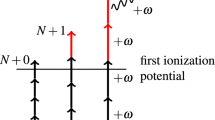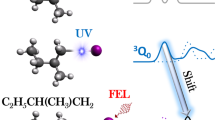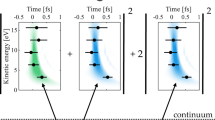Abstract
To be complete, the characterization of the photoionization process of atoms and molecules requires the extraction of all quantum-mechanical phases and amplitudes. So far, complete experiments have accessed only the ionization process of neutral atoms and molecules. Here we report the quantum-mechanically complete characterization of the single and double ionization of neon to yield doubly charged ions. The first ionization step by intense, polarized extreme ultraviolet light from a free-electron laser leaves the ion in a polarized state (that is, one in which the angular momentum of the ion is aligned in space). By controlling the polarization of the light, we determine the bound and continuum components of the system in the first and second ionization steps leading to the formation of doubly charged neon ions. We test the validity of our approach by characterizing the influence of autoionizing ionic states on the two-photon double-ionization mechanism. Our results are important for understanding the physics of the interaction of extreme ultraviolet radiation with ions.
This is a preview of subscription content, access via your institution
Access options
Access Nature and 54 other Nature Portfolio journals
Get Nature+, our best-value online-access subscription
$29.99 / 30 days
cancel any time
Subscribe to this journal
Receive 12 print issues and online access
$209.00 per year
only $17.42 per issue
Buy this article
- Purchase on Springer Link
- Instant access to full article PDF
Prices may be subject to local taxes which are calculated during checkout






Similar content being viewed by others
Data availability
The data that support the plots within this paper and other findings of this study are available from the corresponding author upon reasonable request.
References
Böhme, D. K. Multiply-charged ions and interstellar chemistry. Phys. Chem. Chem. Phys. 13, 18253–18263 (2011).
Thissen, R. et al. Doubly-charged ions in the planetary ionosphere: a review. Phys. Chem. Chem. Phys. 13, 18264–18287 (2011).
Gillaspy, J. D., Pomeroy, J. M., Perrella, A. C. & Grube, H. The potential of highly charged ions: possible future applications. J. Phys. Conf. Ser. 58, 451–456 (2007).
McNeil, B. W. J. & Thompson, N. R. X-ray free-electron lasers. Nat. Photon. 4, 814–821 (2010).
Wabnitz, H. et al. Multiple ionisation of atom clusters by intense soft X-rays from a free-electron laser. Nature 420, 482–485 (2002).
Young, L. et al. Femtosecond electronic response of atoms to ultra-intense X-rays. Nature 466, 56–61 (2010).
Kollath, K. J. Theory for laser photoionisation of excited atoms: n2 P1/2,3/2 states of Cs. J. Phys. B 13, 2901–2919 (1980).
Becker, U. Complete photoionisation experiments. J. Electr. Spectrosc. Relat. Phenom. 96, 105–115 (1998).
Bederson, B. The ‘perfect’ scattering experiment. I. Comm. Atom. Mol. Phys. 1, 41–44 (1969).
Kleinpoppen, H. Analysis of scattering amplitudes in polarized-electron-atom collisions. I. Elastic scattering on one-electron atoms and the excitation process 2S1/2→2P1/2,3/2. Phys. Rev. A 3, 2015–2027 (1971).
Duncanson, J. A. Jr., Strand, M. P., Lindgård, A. & Berry, R. S. Angular distributions of electrons from resonant two-photon ionization of sodium. Phys. Rev. Lett. 37, 987–990 (1976).
Cherepkov, N. A. Spin polarization of photoelectrons ejected from unpolarized atoms. J. Phys. B 12, 1279–1296 (1979).
Heinzmann, U. Experimental determination of the phase differences of continuum wavefunctions describing the photoionisation process of xenon atoms: I. Measurements of the spin polarisations of photoelectrons and their comparison with theoretical results. J. Phys. B 13, 4353–4366 (1980).
Heinzmann, U. Experimental determination of the phase differences of continuum wavefunctions describing the photoionisation process of xenon atoms: II. Evaluation of the matrix elements and the phase differences and their comparison with data in the discrete spectral range in application of the multichannel quantum defect theory. J. Phys. B 13, 4367–4381 (1980).
Kessler, J. The ‘perfect’ photoionization experiment. Comm. Atom. Mol. Phys. 10, 47–55 (1981).
Reid, K. L., Leahy, D. H. & Zare, R. N. Complete description of molecular photoionization from circular dichroism of rotationally resolved photoelectron angular distributions. Phys. Rev. Lett. 68, 3527–3530 (1992).
Cherepkov, N. A. et al. K-shell photoionization of CO: II. Determination of dipole matrix elements and phase differences. J. Phys. B 33, 4213–4236 (2000).
Geßner, O. et al. 4σ −1 inner valence photoionization dynamics of NO derived from photoelectron–photoion angular correlations. Phys. Rev. Lett. 88, 193002 (2002).
Kabachnik, N. M. & Sazhina, I. P. On the problem of a complete experimental characterisation of Auger decay. J. Phys. B 23, L353–L357 (1990).
Grum-Grzhimailo, A. N., Dorn, A. & Mehlhorn, W. On complete experiments for Auger decay. Comm. Atom. Mol. Phy. Comm. Mod. Phys. D 1, 29–39 (1999).
West, J. B., Ross, K. J., Ueda, K. & Beyer, H. J. Angular correlation measurement between the photo-excited autoionized electron and subsequent polarized fluorescent photon at an autoionization resonance of Sr. J. Phys. B 31, L647–L654 (1998).
Hergenhahn, U. et al. Dynamically induced spin polarization of resonant Auger electrons. Phys. Rev. Lett. 82, 5020–5023 (1999).
Becker, U. & Crowe, A. (eds) Complete Scattering Experiments (Kluwer Academic/Plenum, New York, 2001).
Kleinpoppen, H., Lohmann, B. & Grum-Grzhimailo, A. N. Perfect/Complete Scattering Experiments (Springer, Berlin, 2013).
Allaria, E. et al. Control of the polarization of a vacuum-ultraviolet, high-gain, free-electron laser. Phys. Rev. X 4, 041040 (2014).
Flügge, S., Mehlhorn, W. & Schmidt, V. Angular distribution of Auger electrons following photoionization. Phys. Rev. Lett. 29, 7–9 (1972).
Jacobs, V. L. Theory of atomic photoionization measurements. J. Phys. B 5, 2257–2271 (1972).
Caldwell, C. D. & Zare, R. N. Alignment of Cd atoms by photoionization. Phys. Rev. A 16, 255–262 (1977).
Greene, C. H. & Zare, R. N. Photofragment alignment and orientation. Ann. Rev. Phys. Chem. 33, 119–150 (1982).
Allaria, E. et al. Highly coherent and stable pulses from the FERMI seeded free-electron laser in the extreme ultraviolet. Nat. Photon. 6, 699–704 (2012).
Lyamayev, V. et al. A modular end-station for atomic, molecular, and cluster science at the low density matter beamline of FERMI@Elettra. J. Phys. B 46, 164007 (2013).
Covington, A. M. et al. Photoionization of Ne+ using synchrotron radiation. Phys. Rev. A 66, 062710 (2002).
Fritzsche, S., Grum-Grzhimailo, A. N., Gryzlova, E. V. & Kabachnik, N. M. Angular distributions and angular correlations in sequential two-photon double ionization of atoms. J. Phys. B 41, 165601 (2008).
Peshkin, M. in Advances in Chemical Physics Vol. 18 (eds Prigogine, I. & Rice, S. A.) 1–14 (Interscience, New York, 2007).
Gryzlova, E. V., Grum-Grzhimailo, A. N., Fritzsche, S. & Kabachnik, N. M. Angular correlations between two electrons emitted in the sequential two-photon double ionization of atoms. J. Phys. B 43, 225602 (2010).
Nikolopoulos, L. A. A. Time-dependent theory of angular correlations in sequential double ionization. Phys. Rev. Lett. 111, 093001 (2013).
Kaneyasu, T. et al. Autoionization of the Ne+ Rydberg states formed via valence photoemission. J. Phys. B 40, 4047–4060 (2007).
Faye, M. et al. Modified orbital atomic theory calculations of high lying Rydberg series in the photoionization spectra of Ne+. Chin. J. Phys. 53, 100401 (2015).
Edwards, A. K. & Roud, M. E. Excitation of auto-ionizing levels in neon by ion impact. Phys. Rev. 170, 140–144 (1968).
Morgenstern, R., Niehaus, A. & Zimmermann, G. Autoionizing states formed by electron capture in collisions of multiply charged Ne ions with He, H2 and Xe. J. Phys. B 13, 4811–4831 (1980).
Braune, M. et al. Electron angular distributions of noble gases in sequential two-photon double ionization. J. Mod. Optics 63, 324–333 (2016).
Cooper, J. & Zare, R. N. Angular distribution of photoelectrons. J. Chem. Phys. 48, 942–943 (1968).
Cooper, J. W. & Zare, R. N. in Lectures in Theoretical Physics Vol XI-C (eds Geltman, S. et al.) 317 (Gordon and Breach, New York, 1969).
Grum-Grzhimailo, A. N., Gryzlova, E. V., Fritzsche, S. & Kabachnik, N. M. Photoelectron angular distributions and correlations in sequential double and triple atomic ionization by free electron lasers. J. Mod. Optics 63, 334–357 (2016).
Gómez de Castro, A. I. & Wamsteker, W. (eds) Fundamental Questions in Astrophysics: Guidelines for Future UV Observatories (Springer, Dordrecht, 2006).
Svetina, C. et al. The Low Density Matter (LDM) beamline at FERMI: optical layout and first commissioning. J. Synchrotron Radiat. 22, 538–543 (2015).
Balashov, V., Grum-Grzhimailo, A. & Kabachnik, N. Polarization and Correlation Phenomena in Atomic Collisions: A Practical Theory Course (Plenum, New York, 2000).
Kabachnik, N. & Sazhina, I. Angular distribution and polarization of photoelectrons in the region of resonances. J. Phys. B 9, 1681–1697 (1976).
Baier, S., Grum-Grzhimailo, A. & Kabachnik, N. Angular distribution of photoelectrons in resonant photoionization of polarized atoms. J. Phys. B 27, 3363–3388 (1994).
Cowan, R. D. The Theory of Atomic Structure and Spectra (Univ. California Press, Berkeley, 1981).
Acknowledgements
Financial support by the Italian Ministry of Research (project FIRB no. RBID08CRXK) is gratefully acknowledged. This project has also received funding from the European Union’s Horizon 2020 research and innovation programme under the Marie Sklodowska-Curie grant agreement no. 641789 MEDEA. D.F and M.N. acknowledge support from the European Research Council Starting Research Grant UDYNI (grant agreement no. 307964). K.U. acknowledges support by the X-ray Free Electron Laser Utilization Research Project and the X-ray Free Electron Laser Priority Strategy Program of the Ministry of Education, Culture, Sports, Science and Technology of Japan (MEXT), by the Cooperative Research Program of ‘Network Joint Research Center for Materials and Devices: Dynamic Alliance for Open Innovation Bridging Human, Environment and Materials’, by the bilateral project CNR-JSPS ‘Ultrafast science with extreme ultraviolet Free Electron Lasers’ and by the IMRAM project for the international co-operation. M.M. acknowledges support by the Deutsche Forschungsgemeinschaft (DFG) under grant no. SFB 925.
Author information
Authors and Affiliations
Contributions
K.U., G.S. and A.N.G.-G. conceived the present study. M.R., D.F., M.N., K.U., F.F., F.S., Y.O., M.M., O.P., P.F., K.C.P., C.C. and G.S. conducted the experiment. P.A.C. analysed the experimental data. A.D. contributed to the development of the analysis programmes. E.V.G., S.M.B. and A.N.G.-G. developed the theoretical background and performed the numerical simulations. E.V.G., A.N.G.-G. and G.S. drafted the manuscript. All authors discussed the experimental results and the final version of the manuscript.
Corresponding authors
Ethics declarations
Competing interests
The authors declare no competing interests.
Additional information
Publisher’s note: Springer Nature remains neutral with regard to jurisdictional claims in published maps and institutional affiliations.
Supplementary information
Supplementary Information
1 chapter, 3 figures, 6 references, 3 tables, 13 equations
Rights and permissions
About this article
Cite this article
Carpeggiani, P.A., Gryzlova, E.V., Reduzzi, M. et al. Complete reconstruction of bound and unbound electronic wavefunctions in two-photon double ionization. Nature Phys 15, 170–177 (2019). https://doi.org/10.1038/s41567-018-0340-4
Received:
Accepted:
Published:
Issue Date:
DOI: https://doi.org/10.1038/s41567-018-0340-4
This article is cited by
-
Attosecond dynamics of multi-channel single photon ionization
Nature Communications (2022)



